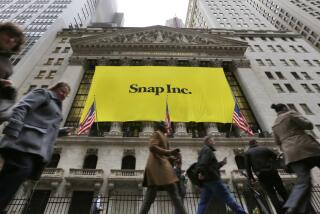Harmon Called a ‘Leader With Vision’
- Share via
WOODLAND HILLS — In the 20 years since El Camino Resources began buying and leasing used computers and office equipment, co-founder Dave Harmon has changed directions several times to keep the company viable--not an easy task in a rapidly changing field where a computer may be obsolete by the time you boot it up.
But a prudent business plan, understanding changing technology and a flexible attitude has allowed the Woodland Hills firm not only to survive, but also to flourish in the information technology field. Harmon was named Financial Services Entrepreneur of the Year for the Greater Los Angeles area by Ernst & Young earlier this year, and is now in the running for the national honor, which will be announced Nov. 13.
The company’s growth, employment figures, international contracts and a proven track record are among the reasons El Camino was recognized, according to Jim Peters, an Ernst & Young partner and director of the Entrepreneur of the Year program in Los Angeles.
“It’s a pretty substantial company that has grown well,” Peters said. “It has a global reach, has been around more than three years [one of the judging criteria]; the entrepreneur who started it is still active and has some personal investment, it has a proven track record and has provided jobs.”
El Camino’s success and staying power can be attributed directly to Harmon, said Steve Groth, managing director at Fleet Bank in New York, which provides some of El Camino’s financing.
“He’s a leader with a lot of vision,” Groth said. “He built a company from scratch to be one of the largest independent leasing companies in the country. A number of mid-market and Fortune 500 companies depend on his counsel to provide advice and equipment and to give them flexibility down the road to change and upgrade.”
Harmon and co-founder David Wolff began the business in 1978 with a $40,000 line of credit.
“We had to pledge all our assets, even our homes,” said Harmon, who is president and CEO. “We didn’t take a salary for a year, but we never had a problem making payroll.”
After five years, he said, “We reached $27 million in revenues.”
Today, the company (which added partner Mel Kleinman in 1981) has about 1,100 employees, including two of Harmon’s three sons, and a wide range of services. The company still leases, sells and re-markets high-technology equipment, such as computing and communications products, to banking, entertainment, telecommunications and other businesses in 13 countries, including the United States, and Europe. But it also provides application-specific services, such as customized software. The major part of its leasing is to banks and data processing out-sourcing companies.
“Our product scope is greater than it was when we first started,” Harmon noted. “At first, it was only used computers--main frames and mid-frames. But communications is a bigger environment now.”
Harmon, 60, who earned an MBA from Michigan State, learned his technology skills mostly on the job, first as a salesman for IBM. When he decided to go into business for himself, he said, “It made sense to go into the leasing end, rather than the manufacturing end, because the technology was changing so rapidly.”
Twenty years ago, he said, business computers could usually be re-leased at least twice after the initial user, and the machines had a life cycle of six to seven years. But as technology improved, companies no longer wanted old equipment, even at bargain rates.
“We could see that soon you wouldn’t be able to sell the equipment twice,” Harmon said. “We could see that second trade disappearing. In 1988, we started to trade new equipment as well as used and became a reseller for IBM. We’re moving further away from used.”
The reselling arm of the company added to El Camino’s growth, posting $244 million in revenue in fiscal 1999. As the company saw lessening value in trading used equipment, the business focus shifted yet again, adding service elements. “We had to become a solutions provider,” offering software applications and computing, storage and data transmission services, he said.
El Camino also expanded overseas and now half of the company’s lease assets are outside the U.S. Clients include MCI and Host International domestically, as well as Deutsche Banke in Germany.
While some competitors dropped by the wayside, El Camino survived “by being prudent in leasing and understanding the technology,” Harmon said. “We’ve morphed the corporation three or four times since we started. We’re still doing it.”
Keeping up with technological changes and understanding the customer’s needs are also challenges, he added.
“The major problem has been keeping up with the technology, keeping yourself fresh, not becoming a dinosaur,” he said. “Don’t ever let yourself become too comfortable.”
For any business, he noted, you must also be able to forecast revenue. If he were advising similar “capital intensive” ventures today, he said, he would urge them to do a forecast, “then cut your gross by 40%. Don’t get the corporation into a situation where you’re counting on business that isn’t there.”
El Camino, he said, projects only three years ahead because “in 10 years I have no idea what [the business landscape] will look like.” At an upcoming business planning meeting “We will take a look at the World Wide Web and try to figure out what is happening in that arena and how it will affect our business.” The company is also considering going public to create liquidity.
El Camino’s main competition today is not so much similar businesses, (such as Chicago-based Comdisco), but computer manufacturers who have themselves set up leasing arms.
“The obsolescence of this type of equipment makes it a risky business,” said Groth of Fleet Bank. But Harmon “knows not only the financial side as a lessor but also knows the technical side. He has been very creative in making changes in structure and providing value to his customers.”
Harmon, who lives in Calabasas with his wife of 36 years, said that to be a successful entrepreneur “You have to want to be in business for yourself. And you have to be willing to face failure. The most interesting entrepreneurs are those who have failed and come back. After a failure, they just get up and do it again.”
Tom O’Malia, of the Greif Entrepreneur Center at the Marshall School of Business at USC, said Harmon fits not only the criteria of a good entrepreneur, but is exactly what the Ernst & Young judges are seeking, as well.
“Entrepreneurs enjoy the journey more than the destination,” said O’Malia, who has helped judge the Ernst & Young competition in the past. “Entrepreneurship is a way of life more than a job. That certainly is Dave Harmon.”
More to Read
Inside the business of entertainment
The Wide Shot brings you news, analysis and insights on everything from streaming wars to production — and what it all means for the future.
You may occasionally receive promotional content from the Los Angeles Times.










